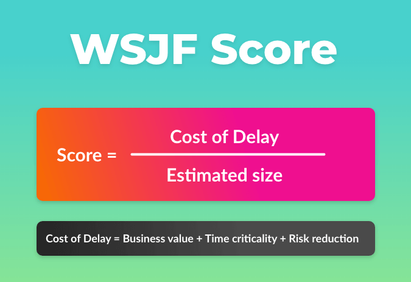Introduction: In the intricate ecosystem of product ownership within the Scaled Agile Framework (SAFe), effective prioritization emerges as the linchpin of success. Amidst the complexities of large-scale projects and competing demands, product owners require a systematic approach to ensure that resources are allocated to initiatives that deliver the most significant value. Enter Weighted Shortest Job First (WSJF), a powerful prioritization technique that empowers product owners to make informed decisions and maximize value delivery within the SAFe framework. In this comprehensive guide, we’ll delve deep into the integration of WSJF within SAFe product ownership, exploring its benefits, implementation strategies, and real-world applications.
Understanding Weighted Shortest Job First (WSJF) in the SAFe Context: Weighted Shortest Job First (WSJF) is a prioritization framework derived from the Scaled Agile Framework (SAFe), tailored to optimize the sequencing of work items based on their value and size within large-scale Agile projects. In SAFe, WSJF serves as a critical tool for product owners to prioritize backlog items and allocate resources effectively across Agile Release Trains (ARTs) and Program Increments (PIs). By calculating the WSJF score for each task, product owners ensure that development efforts align with strategic goals and deliver maximum value to stakeholders and end-users.
Benefits of WSJF for SAFe Product Owners:
- Optimizing Value Delivery Across ARTs: In SAFe, where multiple Agile teams collaborate to deliver complex solutions, WSJF enables product owners to prioritize backlog items and allocate resources across ARTs based on their potential to deliver value. By focusing on tasks with a high WSJF score, product owners ensure that development efforts are aligned with business objectives and strategic priorities.
- Enhancing Program Increment Planning: During Program Increment (PI) planning, WSJF serves as a guiding principle for product owners to prioritize features and capabilities for inclusion in the upcoming PI. By calculating the WSJF score for each feature, product owners facilitate collaborative decision-making and ensure that the PI objectives are achieved with maximum efficiency and effectiveness.
- Managing Dependencies and Risks: WSJF helps product owners identify and prioritize backlog items that mitigate dependencies and address critical risks within the program. By focusing on tasks with a high WSJF score, product owners mitigate project risks and ensure that potential bottlenecks are addressed proactively, minimizing delays and disruptions during the development process.
- Driving Business Value and ROI: At its core, WSJF is designed to maximize value delivery and return on investment (ROI) for SAFe initiatives. By prioritizing backlog items based on their potential to deliver value relative to their size, product owners ensure that resources are allocated to initiatives that offer the greatest impact on business outcomes and customer satisfaction.
Implementing WSJF in SAFe Product Ownership:
- Collaborative Backlog Refinement: Product owners collaborate with stakeholders, Agile teams, and System Architects during backlog refinement sessions to assess backlog items and calculate their WSJF score. By leveraging collective insights and expertise, product owners ensure that backlog prioritization reflects strategic goals and market dynamics.
- PI Planning and Release Train Coordination: During Program Increment (PI) planning, product owners present backlog items with their corresponding WSJF scores to Agile Release Trains (ARTs) for evaluation and selection. By engaging ARTs in the prioritization process, product owners foster alignment, transparency, and buy-in, ensuring that development efforts are coordinated and focused on high-value initiatives.
- Continuous Monitoring and Adaptation: Throughout the PI, product owners continuously monitor backlog priorities and WSJF scores, adapting their prioritization strategy based on feedback, results, and changing business needs. By iterating on the WSJF calculation and adjusting priorities as needed, product owners ensure that resources are allocated to initiatives that maximize value delivery and drive success within the SAFe framework.
Real-World Applications of WSJF in SAFe:
- Feature Prioritization and Roadmap Planning: WSJF enables product owners to prioritize features and capabilities for inclusion in the product roadmap based on their potential to deliver value and strategic alignment. By calculating the WSJF score for each feature, product owners ensure that roadmap priorities are driven by business objectives and customer needs.
- Release Planning and Iteration Execution: During release planning and iteration execution, WSJF helps product owners allocate resources and prioritize backlog items based on their potential to deliver value within the current Program Increment (PI). By focusing on tasks with a high WSJF score, product owners ensure that development efforts are aligned with PI objectives and customer expectations.
Conclusion: In conclusion, Weighted Shortest Job First (WSJF) emerges as a vital tool for product owners navigating the complexities of product ownership within the Scaled Agile Framework (SAFe). By integrating WSJF into their prioritization strategy, product owners can optimize value delivery, enhance collaboration, and drive success across Agile Release Trains (ARTs) and Program Increments (PIs). So, fellow SAFe product owners, embrace WSJF as your guiding principle in the pursuit of value-driven Agile excellence, and unlock the full potential of your initiatives with precision and purpose.
